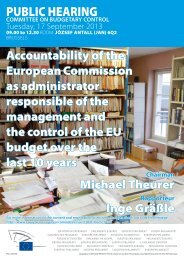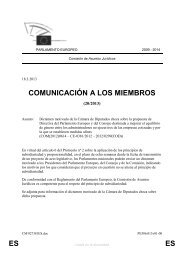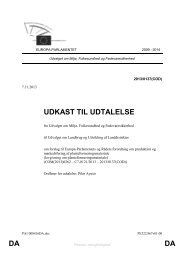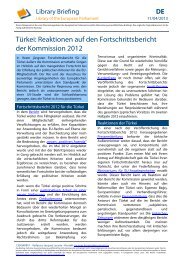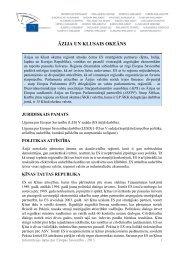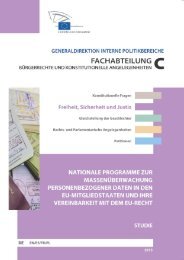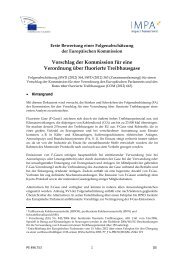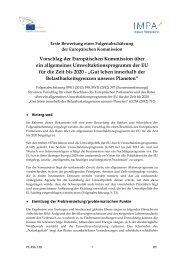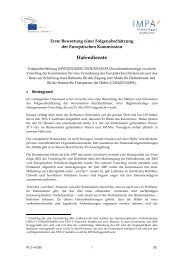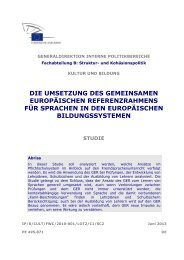Link to the study - European Parliament - Europa
Link to the study - European Parliament - Europa
Link to the study - European Parliament - Europa
You also want an ePaper? Increase the reach of your titles
YUMPU automatically turns print PDFs into web optimized ePapers that Google loves.
Nuclear Decommissioning: Management of Costs and Risks<br />
____________________________________________________________________________________________<br />
4.4.2. Comparison and evaluation of <strong>the</strong> national organisations with best practice<br />
The change processes in <strong>the</strong> two best practice examples EWN and EDF were very different. The<br />
organisation and processes at EWN were changed rapidly because it was already clear at an early<br />
stage that decommissioning was <strong>the</strong> only option and that this requires a completely different<br />
approach (project management). The setup process at EDF only started after <strong>the</strong> basic decision for<br />
decommissioning was taken, but <strong>the</strong>n was consistent and complete.<br />
Compared <strong>to</strong> <strong>the</strong>se two examples, <strong>the</strong> change processes in Bulgaria, Lithuania and Slovakia were<br />
considerably slower, required more interim steps and in some aspects are still not sufficiently<br />
effective. Several reasons played a role in <strong>the</strong> past:<br />
The decision <strong>to</strong> shut <strong>the</strong> plants down was seen as possibly reversible. That kept responsible<br />
management and workforce from adopting <strong>the</strong> task early and with <strong>the</strong> necessary rigor.<br />
Decommissioning was not seen as an ambitious task but much less demanding than operation<br />
of <strong>the</strong> facility. The complexity of this undertaking was generally underestimated.<br />
In <strong>the</strong> first phase <strong>the</strong> management of <strong>the</strong> reac<strong>to</strong>rs had no experiences at all with <strong>the</strong> new<br />
situation and tried <strong>to</strong> manage <strong>the</strong> changed situation with some additions or 'add-ons' <strong>to</strong> <strong>the</strong>ir<br />
organisation until this, years later, proved <strong>to</strong> be inadequate.<br />
In this phase nearly no exchange between <strong>the</strong> three countries was established so that learning<br />
from more advanced countries (e.g. Slovakia) or a systematic, planned and well-organized<br />
experience exchange with <strong>the</strong> o<strong>the</strong>r affected countries and/or with countries having advanced<br />
experiences in decommissioning did not occur.<br />
Organisational issues were in general underestimated so that continuity in <strong>the</strong> established<br />
structures was chosen and kept as long as possible.<br />
These aspects do not play a role any more. From our interviews, site visits and from <strong>the</strong> answers <strong>to</strong><br />
our questionnaire we evaluate <strong>to</strong>day’s internal structures, <strong>the</strong> self-confidence of <strong>the</strong> management<br />
and <strong>the</strong> awareness about <strong>the</strong> necessary changes are well-established in all three countries.<br />
Ano<strong>the</strong>r aspect that was over long periods very different from EWN and EDF’s principal practices was<br />
that <strong>the</strong> main managing and planning instrument, <strong>the</strong> PMU, was constructed outside <strong>the</strong> managing<br />
organisation. The PMU unit consisted of two different member categories:<br />
Experts as employed by, nominated by, reporting <strong>to</strong> and under full control of <strong>the</strong> managing<br />
organisation;<br />
External consultants, as selected, controlled and fully administered by EBRD.<br />
This construction was not in line with <strong>the</strong> framework agreement between <strong>the</strong> countries and EBRD,<br />
which defined <strong>the</strong> task <strong>to</strong> establish PMUs as part of <strong>the</strong> managing organisation and under national<br />
control (see <strong>the</strong> respective text of such an agreement on page 103). Decision-making, not only on<br />
operational but also in strategic issues (see chapter 2.4.3), previously a task between <strong>the</strong> internal PMU<br />
and its controlling ministry, was shifted <strong>to</strong>wards <strong>the</strong> external PMU and EBRD. This PMU design is<br />
shown in Figure 36.<br />
109



